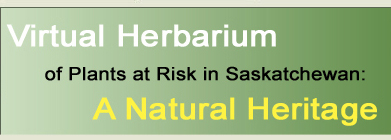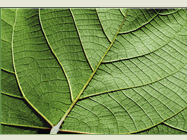|
| Packera pseudaurea
(Rydb.) W.A. Weber & A. Löve |
|
| |
| TAXONOMY |
| |
| Family: |
Asteraceae or Compositae |
| Genus: |
Packera |
| |
| Species Synonyms: |
Senecio pseudaureus Rydb. |
| Common Names: |
golden groundsel
falsegold groundsel |
| |
| DISTRIBUTION |
| |
| Canada: |
British Columbia – southern Saskatchewan
– southern Manitoba |
| Saskatchewan: |
south-central Saskatchewan |
| Ecoregion: |
Cypress Upland, Mixed Grassland, Aspen Parkland |
| |
| HABITAT |
| |
| Saskatchewan: |
meadows, thickets, and open woodlands |
| Associated Species: |
black spruce |
| |
| RARITY STATUS |
| |
Provincial
Status According
to Harms (2003): |
Threatened |
| Nature Conservancy
Status: |
G5 |
Saskatchewan
Species at
Risk Status: |
None |
| COSEWIC Status:
|
None |
| |
| Golden groundsel
is threatened because of rarity in the province. Although its range is relatively
large within Saskatchewan, there are few recorded localities. No immediate
threats are known but are possible in the future. |
| |
| SPECIES
DESCRIPTION |
| |
| Roots: |
30 – 70 cm tall |
| Stems: |
stem base weakly branched, woody, persistent;
sparsely woolly when young, soon essentially hairless |
| Leaves: |
basal and on the stem; basal leaves long-stalked,
woolly in axils, 8 – 15 cm long, 2 – 4 cm wide, oval to broadly
lance-shaped, base heart-shaped to square, apex short-tapered, toothed to
lobed, terminal lobe oval to spoon-shaped; stem leaves sessile (at least
uppermost), 3 – 4 cm long, to 1 cm wide, reduced upwards, pinnately
lobed upwards, margins and leaf axils woolly |
| Inflorescence: |
heads 6 – 20 in branched cluster, to 1 cm
broad; bracts 21 or 13 in a single series, 4 – 6 mm long, long-tapered,
green, brownish at base |
| Flowers: |
ray flowers usually present (13 or 8) and conspicuous,
6 – 10 mm long, yellow |
| Fruits: |
achenes hairless |
| |
| KEY TO PACKERA
IN SASKATCHEWAN |
| Note: This
complex needs taxonomic revision. The key may not be accurate in
all cases. Please refer to another key if you encounter difficulty with
this one. |
| |
|
| 1 Plants usually hairless or nearly
so; basal leaves usually entire or toothed, not lobed |
2 |
| 1 Plants usually woolly-hairy (sometime
glabrous) and/ or with basal leaves; basal leaves if present pinnately lobed
or dissected |
8 |
| |
|
2 Ray flowers 0 or 8 – 13 (petals
2 – 7 mm long); plants of northern Saskatchewan
|
3 |
| 2 Ray flowers 0 or 5 – 21 (petals
4 – 12 mm long); plants from various areas of Saskatchewan |
4 |
| |
|
| 3 Basal leaves thick; heads few (1
– 4); bracts purple or at least purple-tipped |
P. pauciflora |
| 3 Basal leaves thin; head numerous
(8 – 20); bracts green |
P. indecora |
| |
|
| 4 Basal and lower stem leaves not
tapering to stalk, base square to heart-shaped |
5 |
| 4 Basal and lower stem leaves gradually
tapering to stalk |
6 |
| |
|
| 5 Basal leaves lance-shaped to narrowly
oval, tip short-tapered; margin toothed |
P. pseudaurea |
| 5 Basal leaves heart-shaped, spoon-shaped,
or oval, tip rounded; margin toothed, lobed or wavy |
P. streptanthifolia |
| |
|
| 6 Plants with a taproots and woody
persistent stem base; may be woolly in leaf axils |
P. tridenticulata |
| 6 Plants with fibrous, taproots or
rhizomes, persistent stem base if present not woody; leaves and stems generally
all hairless |
7 |
| |
|
| 7 Basal leaves thick, inversely lance-shaped
to spatula-shaped; disc flowers 35 – 60 |
P. streptanthifolia |
| 7 Basal leaves thin, lance-shaped
to elliptic; disc flowers 50 – 80 |
P. paupercula |
| |
|
| 8 Stems and leaves persistently woolly |
P. plattensis |
| 8 Stems and leaves usually hairless,
sometimes woolly at base or in leaf axils |
9 |
| |
|
| 9 Plants 3 – 10 cm tall; heads
few (1-6) |
P. cana |
| 9 Plants 10 – 50 cm tall; heads
several (6 – 30) |
10 |
| |
|
| 10 Basal leaves nearly circular to
broadly oval |
11 |
| 10 Basal leaves narrowly elliptic
to spoon-shaped |
12 |
| |
|
| 11 Margins of basal leaves entire
to toothed; bracts hairless |
P. streptanthifolia |
| 11 Margins of basal leaves toothed
to divided; bracts densely woolly |
P. plattensis |
| |
|
| 12 Basal leaves toothed to lobed;
tangled woolly to nearly hairless |
P. plattensis |
| 12 Basal leaves entire, except towards
toothed tip; white woolly |
P. cana |
|






